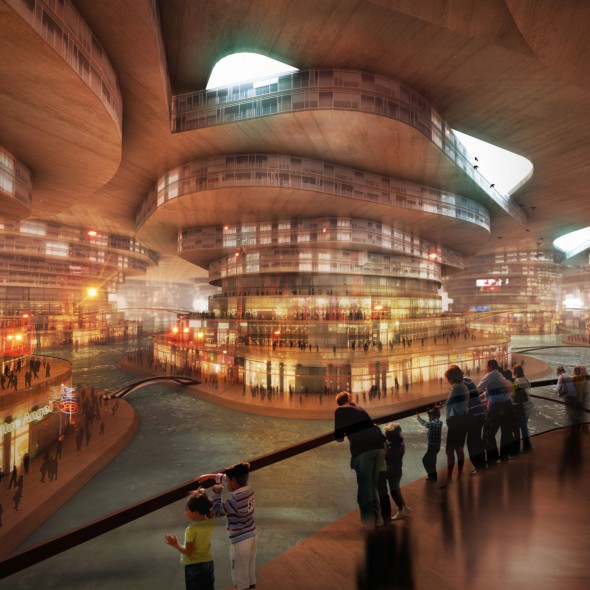
Desert cities, for a generation raised on dreams of Tatooine anyway, are far from a new idea, George Lucas’s sand planet drifted in on a dust clouds left behind by Frank Herbert’s Dune. Before that, authors such as Ray Bradbury and Kim Stanley Robinson mined the sands of Mars to create early environmental allegories that predicted Earth’s demise.
Lately, moreover, the fears of science fiction writers have given way to massive commercial enterprises on a scale that retains the capacity to dazzle. Desert cities from Dubai to Nevada continue to capture the imagination, perhaps because they appeal to both the something-out-of-nothing pioneer spirit and those with a desire to build eco-oasis for after the flood. Only today China announces its China-Vegas a 100 sq km “New World Resort City” in Inner Mongolia, although one presupposes that it will be the former model that will be constructed.
The picture above (via bldg) is from an exhibition entitled Out of Water | innovative technologies in arid climates at the University of Toronto and designed by Matsys, a design studio in San Francisco. Its founder, Andrew Kudless, regards the desert city as a new urban prototype. Here’s why:
“Although this science fiction novel sounded alien in 1965, the concept of a water-poor world is quickly becoming a reality, especially in the American Southwest. Lured by cheap land and the promise of endless water via the powerful Colorado River, millions have made this area their home. However, the Colorado River has been desiccated by both heavy agricultural use and global warming to the point that it now ends in an intermittent trickle in Baja California. Towns that once relied on the river for water have increasingly begun to create underground water banks for use in emergency drought conditions. However, as droughts are becoming more frequent and severe, these water banks will become more than simply emergency precautions.”
Sietch Nevada projects waterbanking as the fundamental factor in future urban infrastructure in the American Southwest. Sietch Nevada is an urban prototype that makes the storage, use, and collection of water essential to the form and performance of urban life. Inverting the stereotypical Southwest urban patterns of dispersed programs open to the sky, the Sietch is a dense, underground community. A network of storage canals is covered with undulating residential and commercial structures. These canals connect the city with vast aquifers deep underground and provide transportation as well as agricultural irrigation. The caverns brim with dense, urban life: an underground Venice. Cellular in form, these structures constitute a new neighborhood typology that mediates between the subterranean urban network and the surface level activities of water harvesting, energy generation, and urban agriculture and aquaculture. However, the Sietch is also a bunker-like fortress preparing for the inevitable wars over water in the region.


























Reply